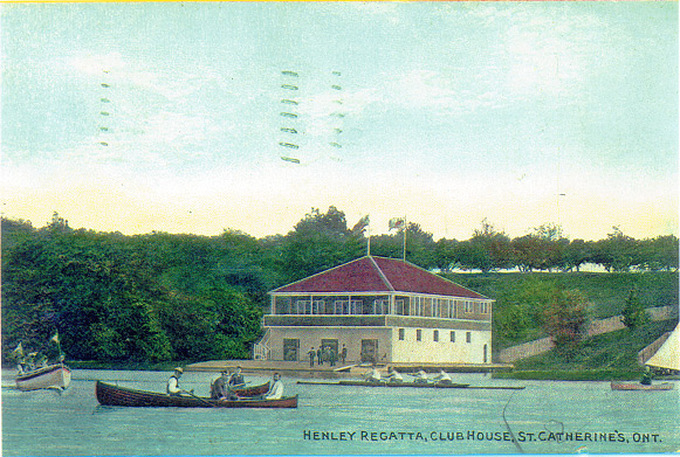|
The St. Catharines Rowing Club owes its origins to the Canadian Association of Amateur Oarsmen. That organization was founded in 1880, and its annual regattas moved from city to city for the first twenty-three years of its life. Regattas were held in Toronto, Hamilton, Brockville, Lachine, Ottawa, and Barrie. The C.A.A.O. selected the site based on incentives offered by the cities. However, such a nomadic existence was not an ideal one, and the executive and member clubs agreed that a permanent site would be preferable. All of the locations used in those first years had drawbacks; unreliable water being the chief one. They were all susceptible to winds, and in some places, river currents and steamer traffic. In 1902, the C.A.A.O. were actively looking for a permanent home for their annual regatta, a home befitting the name Henley, the English regatta on which they wanted to model theirs. In late October, 1902, a committee came to inspect the old canal, and liked what they saw. That 1902 inspection led to an invitation by the St. Catharines Board of Trade to have the C.A.A.O. explain to them what would be involved in holding the regatta here. On March 19, 1903, A.C. Macdonald and Captain R.K. Barker received a warm reception from that group of businessmen. The Board supported the plan, and proceeded to lobby City Hall for the $7,000 needed to get the project started. On Thursday, April 2, 1903, a group estimated at one hundred, participated in the official founding of the St. Catharines Rowing and Canoe Club, electing G.W. Hodgetts its first president. Since the purpose of the Club was to host the C.A.A.O.’s annual regatta, the inclusion of a canoe section seems odd. However, the possibility of having the national canoeing championships on the course is mentioned in newspaper accounts. Perhaps that had something to do with it; the rowing section would host the rowing championship, and the canoe section would host the canoeing championship. Another possibility might have been to establish a broader base for membership. Canoeing was one of the most popular recreational pastimes of the era. There were several canoe liveries in Port Dalhousie, so a canoe club would be sure to attract needed members to a fledgling organization. Since St. Catharines did not have a rowing club in 1902, the question arises as to how the C.A.A.O. were made aware of the potential of the old canal. In his 1933 book, Rowing in Canada Since 1848, Robert S. Hunter says that it was G.W. Hodgetts, manager of the St. Catharines branch of the Bank of Toronto, who invited the C.A.A.O. to examine the old Welland Canal. However, an earlier explanation is offered in a 1903 Daily Standard article which credits former St. Catharines resident Norris King with suggesting the old canal at the 1901 C.A.A.O. regatta. And so, with a grant of $2,500 from the city of St. Catharines, a grandstand was built a little north of where the current finish tower stands. It held approximately 900 spectators, and was completed in time for the first Canadian Henley Regatta in 1903. The grandstand was built before the clubhouse for economic reasons; it would generate revenue. The regatta was a huge success. Newspaper accounts estimate the size of the crowd on the second and final day of the event at 10,000. To put that figure in some perspective, the population of St. Catharines in the 1901 census was just under 10,000. Because there was no shellhouse in 1903, the Regatta organizers needed a place to store the delicate shells; the finish on the wooden boats tended to blister in the sun, so they had to be stored in the shade. In 1903, there were 13 finals and six heats, and most races had a maximum of three boats in them, so it was a small number of shells that needed protection. Someone suggested using the gate-yard building. The gate-yard building was built in the 1880s, and was part of a group of buildings called the gate yard where the lock gates for the third Welland Canal were built and repaired. That particular building was close to the steamer dock and the rail siding so shells could be off-loaded and carried there. In 1904, the first clubhouse was built at the south end of the course, on the west side, close to where the starting gates are now located. It was a stylish two-storey building. The lower floor was used for the storage of boats, and the upper floor was used for social functions. The St. Catharines Rowing and Canoe Club had no entries in the first four Henleys. Its first win was in 1908 in the Junior Work Boat Four, an event for “Junior Clubs”, that is, clubs with few members and little equipment. Another Club crew won the same event in 1913. It wasn’t until 1914 that a Club member won a Henley race in a racing shell. In that year, Alan H. Greenwood won the Junior Single at Henley, duplicating his win at the Dominion Day Regatta a few weeks earlier.
After the 1915 Henley, rowing was suspended for the duration of the First World War. When the Henley resumed in 1919, the facilities were in a shambles. The grandstand was in need of repairs, and one source says that the clubhouse had fallen down. Both structures were built on pilings and were at the mercy of winter ice. The newspapers mention only two local scullers in that period, and they were rowing out of the Pastime Club, so it’s probable that there was no St. Catharines Rowing and Canoe Club. Not only were there no facilities, but a large number of members had lost their lives in the War. During the 1919 and 1920 Henleys, competitors’ equipment was stored at the gate-yard building. It was the only place available. In 1921, the Henley Aquatic Association was formed and Fred Foote was elected its first Chairman. It was not a rowing club (although Fred Foote was a competitive sculler), but an organization made up of former Rowing Club members, whose sole purpose was to run the regatta and maintain the facilities. The first project they undertook was building a new shellhouse for Henley competitors. After a drive for funds which fell far short of their goal, a one-storey building was constructed at the foot of Ann Street, just a little south of the current grandstand. Ralfe J. Clench’s win in the 140 lb. Single at the 1921 Henley illustrates the confusion regarding his club’s identity at that time. The newspaper reports say he sculled for the Henley Aquatic Association (which was not a rowing club), while the C.A.A.O. record book says he sculled for the St. Catharines Rowing Club. However, to add to the confusion, both he and Fred Foote, the only other local competitor in 1921, sculled out of the Pastime Club. In the fall of 1921, the Niagara District Aquatic Club was formed by members of the original Club, and a local rowing club was re-established. They took up residence in the second shellhouse. After a couple of years, the name became the St. Catharines Rowing Club. The Henley was extremely popular after the First World War. It was expanded to three days, and the competitors began clamoring for improvements to the facilities. The course was silting up and the wooden grandstand was in continual need of repair. In April 1929, it was blown over. It was set up again in time for the 1929 Henley, but without its roof. In 1930, the H.A.A. persuaded the federal government to dredge the course, and in 1931, they put on a major drive to raise funds to build a new grandstand and shellhouse. In the space of one month, in the depth of the Depression, they raised $28,167 of the $29, 900 needed to build the grandstand. It was completed in time for the 1931 Henley, but the second shellhouse had to be knocked down to provide spectators with an unobstructed view of the course. Once again, the St. Catharines Rowing Club was without a home, since the drive for funds to build a new shellhouse had fallen short. Their equipment was stored in the gate-yard building along with that of the visiting competitors. However, in 1932, the H.A.A. built the third shellhouse at the foot of Michigan Avenue. It was used by visiting competitors during Henley, and by the St. Catharines Rowing Club the rest of the year. In 1936, the H.A.A. leased the gate-yard building, and that became the home of the St. Catharines Rowing Club until 1967. The Club had a few successes in the 1920s and 1930s, most notably the Junior Eight in 1929 - the Club’s first eight win at Henley - but it was no match for the powerhouse clubs like the Argonauts. Membership declined during the Second World War to the point that there were only nine Club competitors at the 1941 Henley. Things began to change in 1945 when Don Thom became President and saved the Club from possible dissolution. Under his leadership, Club membership grew and success followed. There was even a women’s program which began in 1947 and disbanded in 1949, for lack of competition. Most of the Club’s 641 Henley wins (including four by the Niagara District Aquatic Club) have come since 1946, the year Club crews won both the Junior and Senior 145 lb. Eights and the Junior 155 lb. Eight. Read’s Island was purchased in 1955, and renamed Henley Island. In 1966 and 1967, it was expanded and the fifth shellhouse was built on an expanded portion of the island. The steel framework for the building came from what had been the forge building at the Welland Vale Manufacturing Co.. The fifth shellhouse was completed just before Henley in 1967, and the fourth shellhouse was abandoned on the weekend before the regatta started, ending a connection with Henley which had begun 64 years earlier, in 1903. Out of that fifth shellhouse, in addition to the successful club program, the Rowing Club sponsors or co-sponsors a rowing school for elementary school children, a large high school program, and a very popular recreational rowing league, which is primarily for men and women who have no previous rowing experience. The club program also includes Masters and Para men and women. From a suggestion in 1901 by a former St. Catharines resident has grown the complex we see today around Martindale Pond, and a Club with no competitive rowers in 1903 now annually boats over 1,000 of all ages and abilities. [For a thorough, illustrated history of the St. Catharines Rowing Club, see Stan Lapinski’s book The St. Catharines Rowing Club: 100 Years in a Row, available for purchase from Mr. Books http://mrbooks.ca/ and Gold Medal Photos http://goldmedalphotos.com/ ] |
St. Catharines Rowing ClubThe St. Catharines Rowing Club has a long tradition of competing at the highest level in the sport of rowing. Categories
All
Archives
November 2023
|
Please Support Our Sponsors
SIGNATURE
PLATINUM
GOLD
SILVER
BRONZE
© 2014, St. Catharines Rowing Club
St. Catharines Rowing Club, P.O. Box 28010, 600 Ontario St., St. Catharines, ON, L2N 7P8.
St. Catharines Rowing Club, P.O. Box 28010, 600 Ontario St., St. Catharines, ON, L2N 7P8.
































